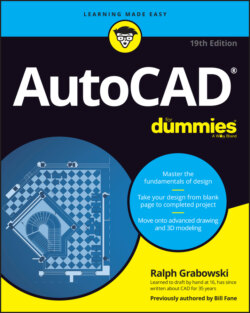Читать книгу AutoCAD For Dummies - Ralph Grabowski - Страница 49
A Template for Success
ОглавлениеWhen you start in either the Drafting & Annotation workspace (as I do throughout this book) or the old AutoCAD Classic workspace, AutoCAD creates a new, blank drawing configured for 2D drafting. Depending on where you live (your country, not your street address!) and the dominant system of measure used there, AutoCAD will base this new drawing on one of two default drawing templates:
acad.dwt for the imperial system of measure, as used in the United States
acadiso.dwt for the metric system, used throughout most of the rest of the galaxy
In AutoCAD LT, the two default templates are acadlt.dwt and acadltiso.dwt. When you create a new drawing by using the big New icon, the new drawing is based on the default template. On the other hand, if you use the NEW command in the Application (red A) menu or from the NEW icon in the Quick Access menu, the Select Template dialog box appears, as shown in Figure 4-2, so you can choose a template on which to base your new drawing.
You may be familiar with Microsoft Word or Excel template files, and AutoCAD drawing templates work pretty much the same way because Autodesk stole the idea from them, encouraged, of course, by Microsoft, although one could argue that it was the other way around.
FIGURE 4-2: A toolbox of templates.
A template is simply a drawing whose name ends in the letters DWT, which you use as the starting point for another drawing. When you create a new drawing from a template, AutoCAD makes a copy of the template file and opens the copy in a new drawing editor window. The first time you save the file, you’re prompted for a new filename to save to; the original template file stays unchanged.
Using a suitable template can save you time and worry because many of the setup options are already set correctly for you. You know the drawing will plot correctly; you just have to worry about getting the geometry and text right. Of course, all this optimism assumes that the persons who set up the template knew what they were doing.
The stock templates that come with AutoCAD are okay as a starting point, but you’ll want to modify them to suit your purposes or create your own from scratch. In particular, the stock AutoCAD templates are probably not set up for the scales or layers you’ll want to use. The instructions in the rest of this chapter tell you how to specify scale-dependent setup information.
So, the only problems with templates are creating good ones and then later finding the right one to use when you need it. Later in this chapter, in the “Making Templates Your Own” section, I show you how to create templates from your own setup drawings. Here I show you how to use an already-created template — say, one of the templates that comes with AutoCAD or one you get from a CAD-savvy colleague. If you’re lucky, someone in your office has created suitable templates that you can use to get going quickly.
Follow these steps to create a new drawing from a template drawing:
1 Run the NEW command by pressing Ctrl+N or clicking the Application button and choosing New.The Select Template dialog box appears.
2 Click the name of the template you want to use as the starting point for your new drawing and then click the Open button.A new drawing window with a temporary name, such as Drawing2.dwg, appears. The template you opened remains unchanged on your computer’s hard drive.Depending on which template you choose, your new drawing may open in a paper space layout, not in model space. If that’s the case, click the Model button on the status bar before changing the settings described in the next section. I describe how to set up and take advantage of paper space layouts in Chapter 16.
3 Press Ctrl+S or click the Application button and choose Save to save the file under a new name.Take the time to save the drawing to the appropriate name and location now.
4 Make needed changes.With most of the templates that come with AutoCAD, consider changing the units, limits, grid and snap settings, linetype scale, and dimension scale. See the next section for instructions.
5 Save the drawing again.If you’ll need other drawings in the future similar to the current one, consider saving your modified template as a template in its own right. See the section “Making Templates Your Own,” later in this chapter, for the lowdown on saving templates.
A few of the remaining templates that come with AutoCAD include title blocks for various sizes of sheets. In addition, most templates come in two versions: one for people who use color-dependent plot styles and one for people who use named plot styles. You probably want the color-dependent versions. Chapter 16 describes the two kinds of plot styles and why you probably want the color-dependent variety.
